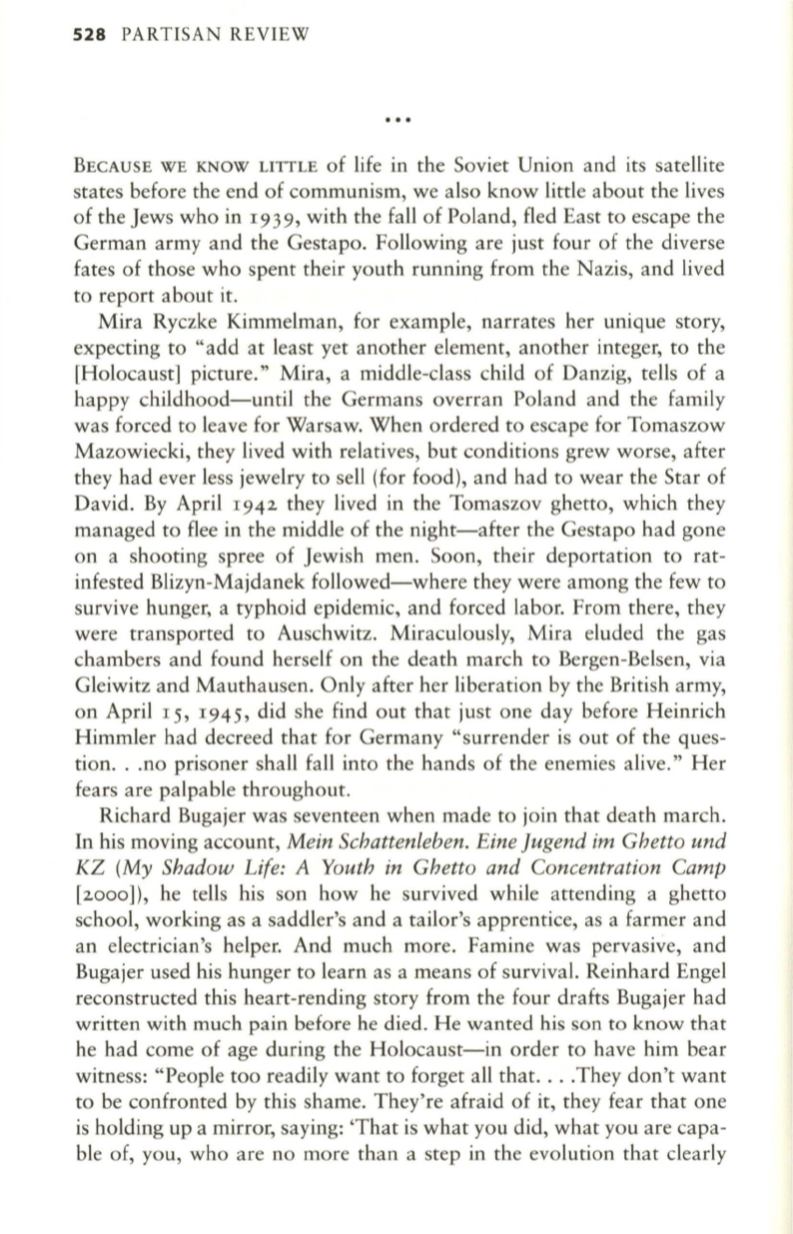
528
PARTISAN REVIEW
BECAUSE WE KNOW LITTLE of life in the Soviet Union and its satellite
states before the end of communism, we also know little about the lives
of the Jews who in
I939,
with the fall of Poland, fled East to escape the
German army and the Gestapo. Following are just four of the diverse
fates of those who spent their youth running from the Nazis, and lived
to
report about it.
Mira Ryczke Kimmelman, for example, narrates her unique story,
expecting to "add at least yet another element, another integer, to the
[Holocaust] picture." Mira, a middle-class child of Danzig, tells of a
happy childhood-until the Germans overran Poland and the family
was forced to leave for Warsaw. When ordered to escape for Tomaszow
Mazowiecki, they lived with relatives, but conditions grew worse, after
they had ever less jewelry to sell (for food), and had
to
wear the Star of
David. By April
I942
they lived in the Tomaszov ghetto, which they
managed to flee in the middle of the night-after the Gestapo had gone
on a shooting spree of Jewish men. Soon, their deportation
to
rat–
infested Blizyn-Majdanek followed-where they were among the few to
survive hunger, a typhoid epidemic, and forced labor. From there, they
were transported to Auschwitz. Miraculously, Mira eluded the gas
chambers and found herself on the death march to Bergen-Belsen, via
Gleiwitz and Mauthausen. Only after her liberation by the British army,
on April
I5, I945,
did she find out that just one day before Heinrich
Himmler had decreed that for Germany "surrender is out of the ques–
tion...no prisoner shall fall into the hands of the enemies alive." Her
fears are palpable throughout.
Richard Bugajer was seventeen when made
to
join that death march.
In his moving account,
Mein Schatten/eben. Eine Jugend im Ghetto und
KZ (My Shadow Life: A Youth in Ghetto and Concentration Camp
[2000]),
he tells his son how he survived while attending a ghetto
school, working as a saddler's and a tailor's apprentice, as a farmer and
an electrician's helper. And much more. Famine was pervasive, and
Bugajer used his hunger to learn as a means of survival. Reinhard Engel
reconstructed this heart-rending story from the four drafts Bugajer had
written with much pain before he died. He wanted his son to know that
he had come of age during the Holocaust-in order to have him bear
witness: "People too readily want to forget all that... .They don't want
to be confronted by this shame. They're afraid of it, they fear that one
is holding up a mirror, saying: 'That is what you did, what you are capa–
ble of, you, who are no more than a step in the evolution that clearly


